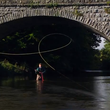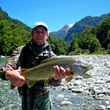Between Jan. 19 and March 20, nearly 80,000 Americans took the time to submit comments to the Georgia Department of Environmental Protection on the merits of a proposed heavy-mineral sand mine on the fringes of the Okefenokee National Wildlife Refuge near Georgia’s southern border with Florida.
According to Sara Lips, public information officer with the DEP, the total number of comments on the proposed mine actually eclipses 100,000 — the DEP received an additional 27,000 comments before the comment period opened.
Twin Pines Minerals LLC is proposing a 582-acre mine on Trail Ridge, a sand ridge that, millions of years ago, was a barrier island in the Atlantic Ocean. Today, Trail Ridge marks the eastern boundary of the iconic Okefenokee Swamp. In its natural state, the ridge is grown over by pines and other native flora. But beneath the vegetation lies fine white sand that contains important minerals, like titanium dioxide and zirconium. These heavy minerals show up in the white sand as little dark flakes — like ground pepper in a sea of fine salt.
The ridge is a vital geological feature because it helps contain the largest remaining blackwater swamp in the United States. Biologists from all over the South worry that mining the ridge will change the hydrology of the region and permanently lower the water levels in the Okefenokee.
“Trail Ridge acts as an earthen dam that creates the swamp itself. It does this by redirecting surface water drainage and slowing surficial groundwater movement, creating a backwater effect,” reads an open letter to the south Georgia community written by 87 university professors, biologists, hydrologists and other scientists who oppose the mining proposal. “Digging up Trail Ridge and then replacing it post-mining will mix the existing layered sands, clays, and organic matter. This makes Trail Ridge more porous and thus more conductive to water, lessening its ability to hold water. This will alter groundwater flows through Trail Ridge and possibly lead to permanently lower water levels in the (Okefenokee) Swamp."
Twin Pines declined to comment on its plans to mine near the swamp, but its website claims that “mining activities will not impact the Okefenokee Swamp.”
The mining process is fairly complex. First, the site of the mine would be completely razed — any timber, if marketable, would be sold, and all other debris would be burned as slash. Then Twin Pines would use a “dragline,” or a giant scraper pulled by two massive cables, to dig 50 feet below the elevation of the Okefenokee. The sands collected from the mining would then be put in a spiral separator and mixed with produced water from the site.The lighter quartz-based sand would sift out of the top of the spiral, while the heavier target minerals would separate and remain at the bottom.
This material is stored in large piles of black sand, while the "light" sand is then used to fill in the holes dug by the dragline.
Scientists aren’t the only ones worried about water loss in the swamp, which is home to a vibrant recreational fishery that includes everything from chain pickerel and bowfin to flyers and warmouth. The St. Marys Riverkeeper, a non-profit group that monitors the health of the St. Marys River as it flows out of the eastern edges of the Okefenokee before becoming the border between Georgia and Florida, worries that altering the water table of the swamp could alter water levels in the river, too. The Okefenokee serves as the headwaters for both the St. Marys and Suwannee rivers.
Emily Floore, executive director of SMRK, also noted that Twin Pines doesn’t have any sand-mining experience in the area and that her organization worries that the company is using the St. Marys river as a “Guinea pig.”
“Water levels are a serious concern for us,” Floore says. “We have a lot to lose here” if the mine becomes a reality and, as scientists predict, the waterline in the swamp goes down.
Of course, the swamp itself also faces an uncertain fate. One longtime local resident who has spent the bulk of his life floating its waters worries that everything will change if the water drops significantly.
JD Corbett, who’s lived in the area all of his 76 years and who has, over the years, helped the U.S. Fish and Wildlife Service clear water trails and build backcountry camping platforms, claims the swamp needs to be left alone. If the Okefenokee’s water levels drop, he explains, cypress trees will fill in and the lakes and channels will be lost forever. The area would become more susceptible to wildfires, and the changes to the flora and fauna of the region would be lasting — maybe permanent. The area isn’t just home to fish and critters like alligators and otters — it’s home to endangered red-cockaded woodpeckers, black bears and several species of carnivorous plants.
“The swamp is better off left alone,” Cobrett says. “I’d hate to see it destroyed.”
The Georgia DEP, according to Lips, is still collecting comments that were mailed in during the comment process (so the final number will be even higher). Ultimately, it will decide on the merits of the mine proposal, and the public comments will play a role in that decision, unless Georgia Gov. Brian Kemp intervenes and exercises his executive powers to stop the process.
That’s what Deb Haaland, U.S. secretary of the Interior, asked Kemp to do last fall. He never formally responded to Haaland, and directed all media inquiries to Lips at the DEP. In addition to Haaland, both U.S. Sens. John Ossof and Rafael Warnock of Georgia have publicly opposed the mine, as have numerous conservation groups across the South. There was a short-lived effort to stave off the mine in the state House of Representatives, but a bill that could have prohibited mining around the Okefenokee National Wildlife Refuge died in committee earlier in March.
If the state decides to approve the mine?
“I think we have to go to court,” Corbett says. “This isn’t over. As long as there’s blood in my veins, this isn’t over.”
































Comments